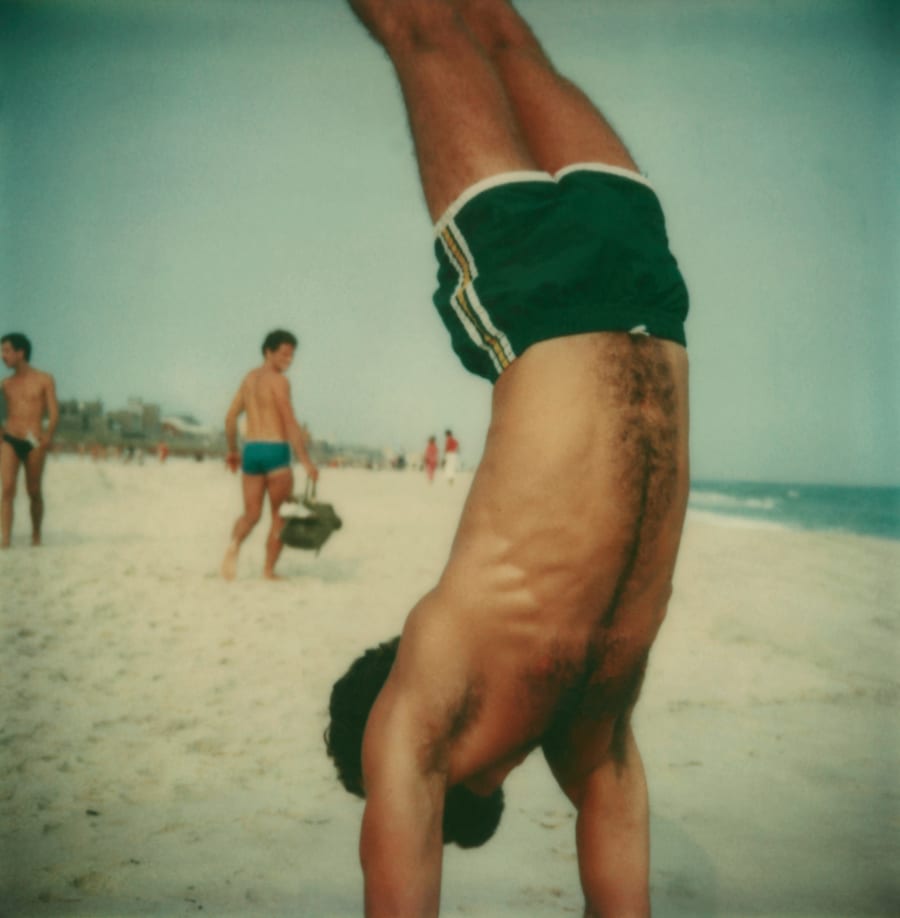In art history, bathing occupies a surprisingly prominent spot. Depicting classically attractive individuals – often men – lounging by or in a body of water has proven popular with artists from ancient Greek potters to contemporary painters. Queer creatives in particular have embraced beach and poolside imagery to celebrate the beauty of the body.
This summer, hundreds of Queer tourists will flock to resort towns around the world to soak in the sea and lie out on sandy beaches. Embedded in the appeal of destinations like Fire Island, Provincetown, Key West, Sitges, Mykonos, and Zipolite is the sense that they stand apart from the wider world and in the residual glow of their storied past, when communities of artists called these places home. But even as developers and art professionals hold hands and insist on a continuity that might not always exist, it is worth thinking about the way these clusters have inspired creativity and but leave the imagination wanting today.
The first gay resort town that occupied my mind was the one closest to home. Laguna Beach, California was only a 15-minute drive down the Pacific Coast Highway from where I grew up, but it loomed large in my imagination as the subject of a wildly popular reality show about the intrigues of wealthy teens. The version of the town that most interested me was that of the 1930s, when it had been an artists’ colony and a getaway for Hollywood’s creative class. The town I had initially written off as hopelessly conservative had a lively gay scene until the 1980s when AIDS, property development, and a rise in right-wing politics all but condemned it to obscurity. The fragments that remained – the odd rainbow flag, the explorer Richard Halliburton’s Hangover House (named because it was both cliffside and boozy), the ‘D’ emblazoned on the chimney of Bette Davis’s former mansion – hardly amounted to a coherent image of the past. Despite the best efforts of a select few to preserve this heritage, Laguna strikes me as an incredibly eerie place.
Half-remembered impressions of an ancient lineage have been a creative boon for multiple generations of Queer artists seeking to build pantheons for their own desires and ambitions. The portraiture of the Greek painter Yannis Tsarouchis (1910–1989), for example, drew on the influence of Byzantine and Hellenistic art. Tsarouchis’s work has the perspective and holy air of an Orthodox icon but it is troubled by the sultry swagger of his favorite subject: half-naked sailors. ‘A revolutionary is not [always] classical,’ the poet Odysseas Elytis said of Tsarouchis, ‘[he] dared to seek Hermes not on Olympus but in Ophilus café.’
British painter John Craxton’s (1922–2009) preoccupation with Greece’s mythology, sunshine, and sexy goat herders inspired brilliantly graphic landscapes, halfway between knotty Cubism and the geometric flatness of the images on the side of an ancient urn. In Craxton’s work, the intensity of sun, surf, and sea bleeds through into pyrotechnic displays of color. One can find similar fireworks in paintings by Magnus Enckell (1870–1925), who transposed myths from ancient Rome onto Finland in the summertime, dappling his models with rainbow iridescence.
Film directors have conjured sun-drenched Queer arcadias too. Alain Guiraudie’s Stranger by the Lake (2013) and João Pedro Rodrigues’s The Ornithologist (2016) feature flirtatious protagonists in Edenic settings, while also emphasizing how primal and violent a these idealized, primitive settings can truly be.
Even though ancient Greece continues to be seen as the original setting for pastoral celebrations of male homosexual relationships, the American resort of Fire Island has served as a similarly idealized environment for many artists. This is where the modern hard-bodied homosexual emerged from the sea like Athena from Zeus’s brow. It is also where the motley crew of artists George Platt Lynes, Jared French, George Tooker, and Paul Cadmus found inspiration for their work, which is steeped in gay eroticism. The long shadow of this group is evident everywhere in contemporary art, if not always through direct influence. Think of Louis Fratino’s scenes of Queer intimacy, Thomas McCarty's luminous beach images, or Tom Bianchi’s legendary series of nude photographs, which he has been producing on Fire Island since the 1970s. The resort holds a promise that has seduced LGBTQ+ individuals, especially New Yorkers: You will be transported to a zone where Queer is not only celebrated, but the norm.
Arts organizations like BOFFO do their own part in supporting and maintaining an artist presence on the island. At the same time, to buy too much into the hype is dangerous. Earlier this year, the Australian architect Nigel Smith was roundly made fun of for praising the effects of gentrification while launching the far-out project ‘New Fire Island’. ‘Wouldn’t it be great if you get re-energized by being amongst your LGBTQ family, your rainbow family for 2 weeks, a month per year,’ he asked of his hypothetical new Queer community, a Laguna in the making.
Of all the work churned out about Fire Island in recent years, my favorite is the photographer Matthew Leifheit’s series ‘To Die Alive’. The work is a fever dream of the island’s old architecture, taking detours through the ‘Meat Rack’ until finally ending at the beach itself. For the best shot, Leifheit built a miniature model of the all-male Belvedere hotel only to set it ablaze. It is a thrilling gesture and a radical one too, asking: if a place has maxed out its capacity as an escape, where else can we go?
Harry Tafoya is the Arts Editor at-large for Paper Magazine.
Top image: Thomas McCarty, Beach Hug (detail), 2022. Courtesy of the artist.


